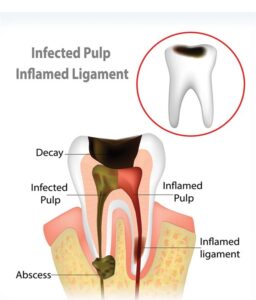Last updated on September 26th, 2024 at 11:15 am
Root canal treatment, often referred to as a “root canal,” is a dental procedure performed to address infections or damage within the innermost part of a tooth known as the pulp. The pulp has blood vessels, nerves, and connective tissues. When this pulp becomes infected or injured due to factors like deep cavities, cracks, or trauma, it can lead to severe toothache and discomfort.
Root Canal Treatment Purpose
The main purpose of root canal treatment is to:
- Relieve Pain: Root canals are often necessary when a toothache becomes excruciating due to pulp infection or inflammation. The procedure aims to alleviate this pain.
- Save the Tooth: Rather than extracting a damaged tooth, which could lead to gaps in your smile and potential alignment issues, a root canal aims to preserve the natural tooth structure.
> Consult a doctor and Order Medicine Online
Procedure of Root Canal Treatment
The procedure involves the removal of the infected or damaged pulp, thorough cleaning, and disinfection of the inside of the tooth, followed by filling and sealing the empty space. A dental crown is typically placed on the treated tooth to strengthen it and restore its function.
Root canal treatment is a common and highly effective dental procedure, allowing patients to retain their natural teeth and eliminate the source of severe toothaches and infections. It is typically performed by a dentist or an endodontist, a specialist in treating the inner structures of teeth.

Root Canal Treatment Steps
Root canal treatment typically involves several steps, and it is a common dental procedure to save a damaged tooth. Here are the key steps involved in a root canal treatment:
- Diagnosis: The first step is to diagnose the need for a root canal. This often involves a thorough examination by a dentist or endodontist (a specialist in root canal procedures). Symptoms that may indicate the need for a root canal include severe toothache, sensitivity to hot and cold, swelling, and tenderness in the gums.
- X-rays: X-rays are taken to visualize the extent of the infection or damage and determine the shape of the tooth’s root canals. This helps the dentist plan the procedure effectively.
- Local Anesthesia: To ensure the patient’s comfort during the procedure, the dentist administers local anaesthesia to numb the affected tooth and the surrounding area.
- Isolation: A rubber dam is placed around the tooth to keep it dry and free from saliva during the procedure. This also prevents contamination.
- Access Opening: The dentist creates a small opening in the crown (top) of the tooth to access the pulp chamber and root canals.
- Cleaning and Shaping: The infected or damaged pulp tissue is carefully removed from the pulp chamber and root canals using specialized instruments. The dentist then cleans and shapes the inside of the tooth to remove any remaining bacteria and debris.
- Disinfection: The cleaned root canals are disinfected to eliminate any lingering bacteria that could cause further infection.
- Filling: After thorough cleaning and disinfection, the dentist fills the empty root canals with a biocompatible material, often a rubber-like substance called gutta-percha, to seal the space and prevent reinfection.
- Restoration: In most cases, a tooth that has undergone a root canal will need a restoration, such as a dental crown, to protect it and restore its function. The crown is custom-made to match the patient’s natural teeth and is placed over the treated tooth.
- Recovery: After the procedure, patients may experience some mild discomfort or sensitivity, but this can usually be managed with over-the-counter pain relievers. Most individuals can return to their normal activities shortly after the procedure.
Read: What are Generic Medicines?
Root canal Treatment
Root canal treatment is highly successful in saving infected or damaged teeth, allowing patients to retain their natural teeth and avoid extraction. It alleviates pain and restores oral health, making it a valuable dental procedure for those in need.
Regular dental check-ups and prompt treatment of dental issues can help prevent the need for root canal therapy in the first place.

Root Canal Aftercare and Maintenance
Following a root canal procedure, patients need to practice good oral hygiene to maintain the health of the treated tooth and prevent future problems. This includes:
- Regular Dental Check-ups: Continue attending routine dental check-ups so your dentist can monitor the treated tooth and the overall health of your mouth.
- Oral Hygiene: Brush your teeth at least twice a day and floss daily to keep your teeth and gums clean and free from plaque and bacteria. Proper oral hygiene helps prevent new infections.
- Avoiding Hard or Sticky Foods: Be cautious with your eating habits, especially immediately after the procedure. Avoid biting on hard objects or consuming sticky foods that could damage the restored tooth.
- Protection: If your dentist places a dental crown over the treated tooth, take care to protect it. Crowns can be durable, but they are not indestructible. Avoid chewing on tough things like ice or pens.
- Pain Management: If you experience any discomfort or pain after the root canal procedure, consult your dentist. They can suggest suitable pain relief options.
- Follow-Up X-rays: Periodic X-rays may be necessary to ensure that the treated tooth is healing properly and that there are no signs of reinfection.
Benefits of Root Canal Treatment
Root canal treatment offers several significant benefits:
- Pain Relief: The primary goal of a root canal is to relieve severe toothache caused by infection or damage to the pulp. Most patients undergo quick relief after the procedure.
- Preservation of Natural Teeth: Root canals allow patients to keep their natural teeth, which is generally preferable to tooth extraction followed by replacement with artificial teeth (e.g., dental implants or bridges).
- Improved Oral Health: By removing the infected pulp and thoroughly cleaning the tooth, root canal treatment eliminates the source of infection and prevents its spread to other teeth or surrounding tissues.
- Efficient Chewing: Restoring the tooth with a crown allows for efficient chewing and maintains proper dental function.
- Cosmetic Benefits: Dental crowns used to restore the tooth can be matched to the colour and shape of your natural teeth, enhancing the appearance of your smile.
Conclusion:
Root canal treatment is a valuable dental procedure that can save a tooth from extraction, relieve pain, and restore oral health. By following proper aftercare and maintenance, patients can expect their treated teeth to function effectively and painlessly for many years.
If you suspect that you may need a root canal or have been recommended for one by your dentist, it’s essential to consult with a dental professional to address your specific needs and concerns. Early intervention can control complications and provide a successful outcome.
FAQs On Root Canal Treatment
Q1. What is the main reason someone might need a root canal?
Root canals are typically needed when the pulp of a tooth becomes infected or inflamed due to deep decay, a cracked tooth, or trauma. The procedure is necessary to remove the infected or damaged pulp, alleviate pain, and save the tooth from extraction.
Q2. Is a root canal treatment a painful procedure?
No, modern root canal treatments are typically not painful. Dentists use local anaesthesia to numb the affected area, ensuring that patients are comfortable during the procedure. After the treatment, there may be some mild discomfort, but this can usually be managed with over-the-counter pain relievers.
Q3. How long does a root canal treatment take, and what is the recovery process like?
The duration of a root canal procedure can vary depending on the tooth’s complexity and the extent of infection. On average, it takes one to two hours. A follow-up visit is often required to place a dental crown on the treated tooth to restore its function and appearance. Proper oral hygiene and regular dental check-ups are essential for a successful recovery.
Related Links:
